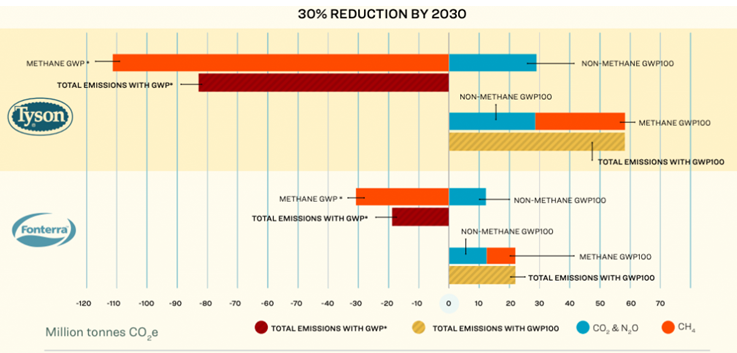

Context:
New method takes current methane emissions as baseline to present minor reductions as negative emissions or cooling.
|
About GPW*
|
|
Greenwashing:
|
Background:
- GWP*: Some of the world’s big, industrialised meat and dairy companies have been promoting a new metric for measuring methane emissions, called GWP* (pronounced as GWP star), which they argue is a more accurate way to calculate emissions from the greenhouse gas (GHG).
- Manipulation of GHGs:However, by adopting this new method, they can manipulate their overall GHG emissions and escape accountability by falsely claiming climate neutrality.
- Under 2015 Paris Agreement: The established metric under the 2015 Paris Agreement for measuring the global warming potential of a gas over a 100-year period is GWP100, which is the global warming potential evaluated over a 100-year timeline. It focuses on the absolute level of emissions.
- GWP100vs GPW*: GWP100 measures the warming effect of a quantity of a non-carbon dioxide (CO2) GHG, emitted at a given point in time, relative to an equal amount of CO2. On the other hand, GWP* focuses on changes in emissions over decadal timescales rather than absolute levels.
|
What Seeing Stars Report Said:
|
- The paper argued that by taking current levels of methane emissions as their baseline, high-polluting countries and companies can use GWP* to present even minor reductions in methane as negative emissions or cooling.
Case Study of Tyson and Fonterra
Tyson Emissions
- The researchers looked at different levels of emissions reductions for Tyson, one of the world’s largest processors of chicken, beef and pork and Fonterra, the largest dairy exporting company.
- Using both GWP100 and GWP* metrics, they found that companies could claim climate neutrality with tiny levels of annual emissions reductions, 4 per cent and 1.7 per cent, respectively, by using the second method.
- Emission reduction for Tyson: With a 30 per cent emissions reductions by 2030, Tyson would be responsible for roughly 5 million tonnes of CO2-equivalent using GWP100. Half of these emissions would be from methane. The emissions amount is similar to the annual emissions of Peru.
- However, using GWP* could enable the company to claim to be reducing around 6 million tonnes of CO2 equivalent from the atmosphere.
Fonterra Emissions
- For Fonterra, a 30 per cent reduction between 2020 and 2030 calculated with GWP* would enable the company to claim negative emissions (efforts in which CO2 is being removed from the atmosphere) of minus 19 million tonnes of CO2 equivalent.
- But GWP100 calculations showed it would still be responsible for roughly 21.6 million tonnes of CO2-equivalent — similar to annual emissions of Sri Lanka.
Case Study of New Zealand:
- A similar trend for New Zealand, where half of all emissions come from agriculture, mostly methane, showed that with a modest 10 per cent reduction in methane emissions, the country could report negative methane using GWP* by 2038.
Efforts to push for GWP*
- The researchers found evidence of the big agriculture lobby pushing the GWP* methodology in New Zealand, Ireland, United States and other regions.
- At least 16 industry groups across the UK and New Zealand, including Beef + Lamb New Zealand and UK farming unions, have jointly urged the IPCC in 2020 to adopt GWP* for assessing warming impacts.
Why GWP* is contentious
- Climate Change Commitment Goals:The ability to easily compare the contributions of different gases to climate change to assign accountability and set fair goals is crucial for global climate commitments. The time horizon used to determine the GWP is important because it affects how much weight is given to short-term warming.
- Lobbying for GPW*:It claimed that the industry and trade groups were heavily lobbying for GWP* to be used in government policy, international standards and private carbon counting initiatives.
- Global Criticism:But it has been criticised on a global policy level because it has the potential to reward the highest historically polluting countries or companies for their past GHG emissions by giving them credit for slight decreases from a high baseline.
- Penalize emitter countries:The methodology will also penalise countries with historically low levels of methane emissions for small increases.




